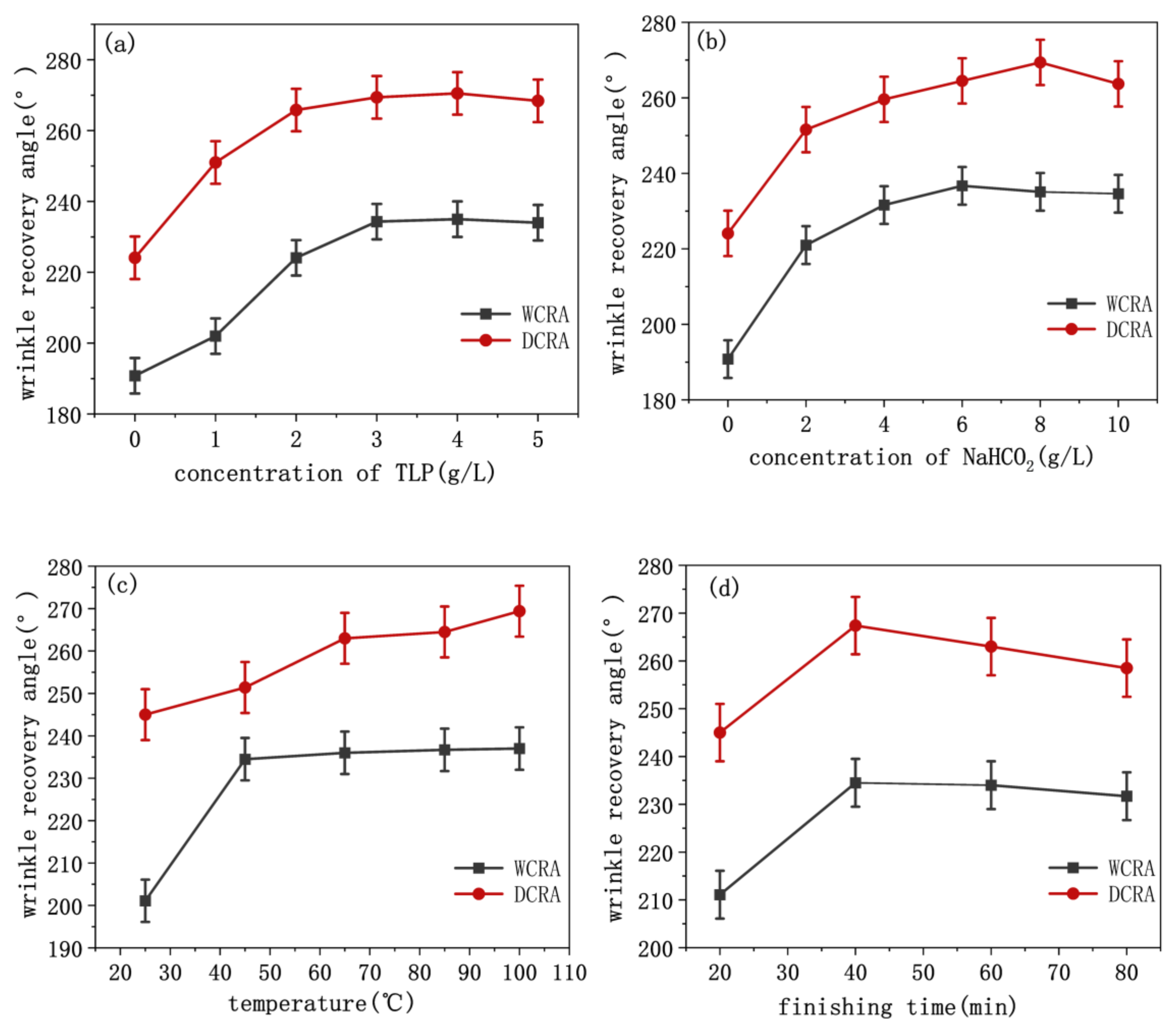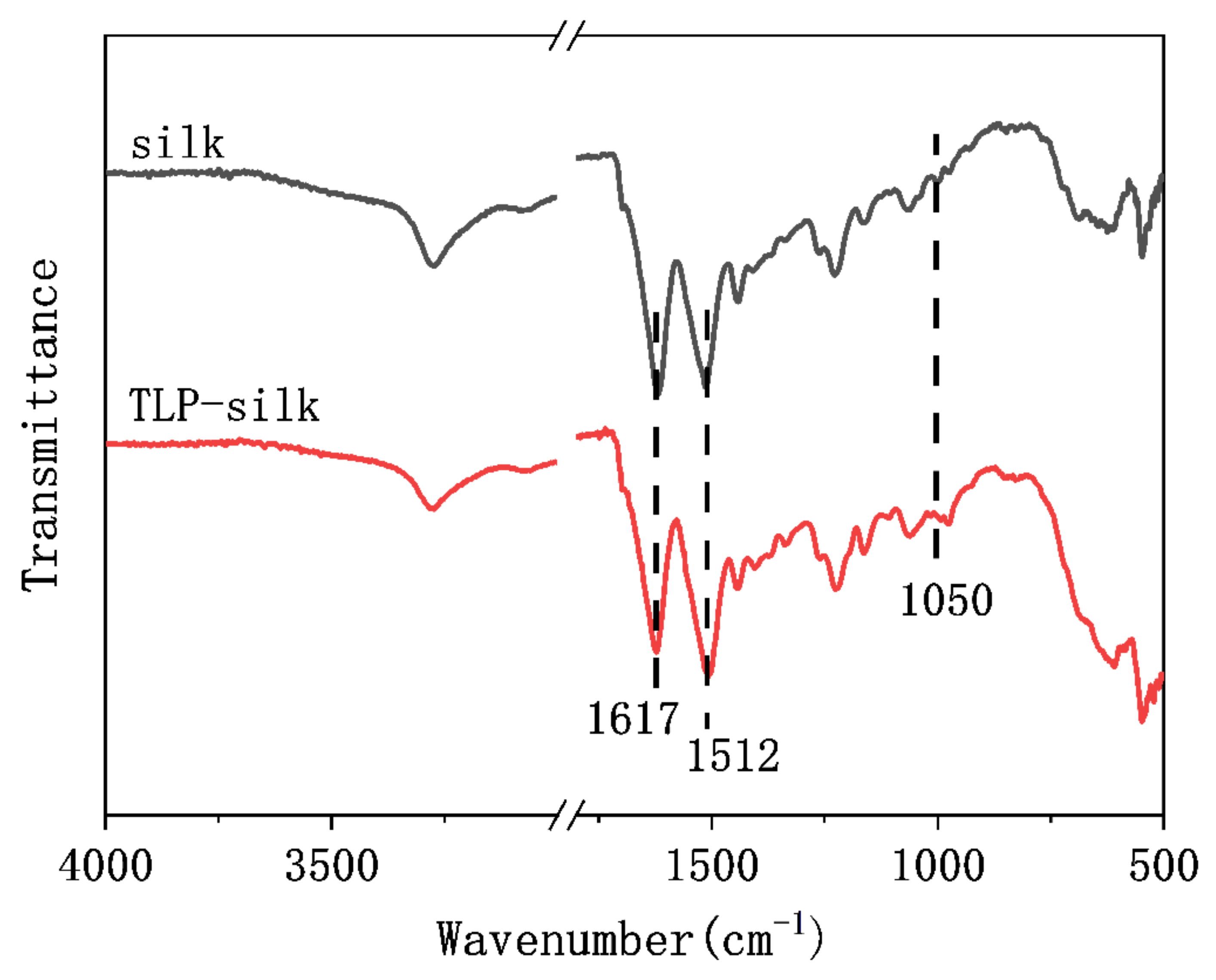Anti-Wrinkle and Dyeing Properties of Silk Fabric Finished with 2,4,6-Trichloropyrimidine
Abstract
:1. Introduction
2. Materials and Methods
2.1. Materials and Reagents
2.2. Preparation and Characterization of Dispersed Emulsions
2.3. Preparation of TLP-Finished Silk
2.4. Dyeing of Silk
2.5. Characterization and Measurements
2.5.1. Finishing Agent Emulsion Particle Size Test
2.5.2. Anti-Wrinkle Properties of Silk Fabrics
2.5.3. The Surface Morphology and Structure of the Finished Fabric
2.5.4. Durability to Washing
2.5.5. Mechanical Properties
2.5.6. Whiteness Index
2.5.7. Color Measurements
3. Results and Discussion
3.1. Effect of Particle Size of Finishing Agent Emulsion on Crease Recovery Angle of Finished Silk Fabrics
3.2. Effects of Reaction Conditions on Anti-Wrinkle of TLP-Finished Silk Fabrics
3.3. Surface Morphology and Chemical Structure
3.4. Washing Durability and Whiteness
3.5. Dyeing Properties
4. Conclusions
Author Contributions
Funding
Institutional Review Board Statement
Informed Consent Statement
Data Availability Statement
Conflicts of Interest
References
- Yang, Y.; Li, S. Silk Fabric Non-formaldehyde Crease-resistant Finishing Using Citric Acid. J. Text. Inst. 1993, 84, 638–644. [Google Scholar] [CrossRef]
- Yang, Y.; Li, S. Crease Resistant Finishing of Silk Fabric with BTCA. Text. Chem. Colorist 1994, 26, 25–29. [Google Scholar]
- Guan, J.; Chen, G. The characteristics of the important function of nature silk finishing. Sichuan Silk 2004, 1, 26–28. [Google Scholar]
- Sekar, N. Recent developments in textile finishing. Colourage 1999, 46, 39–40. [Google Scholar]
- Zou, F.; Ye, Y. The survey and development tendency of pure silk auxiliary. Print. Dye. Aux. 1988, 5, 10–12. [Google Scholar]
- Reid, J.D.; Arceneaux, R.; Reinhardt, R.M.; Harris, J.A. Studies of wrinkle resistant finishes for cotton textiles: I. Release of formaldehyde vapors on storage of wrinkle resistant cotton fabrics. Am. Dyest. Report. 1960, 49, 490–531. [Google Scholar]
- Sewekow, U. How to Meet the Requirements for Eco-Textiles. Text. Chem. Colorist 1996, 28, 21–27. [Google Scholar]
- Wei, W.; Yang, C.Q. Polymeric Carboxylic Acid and Citric Acid as a Nonformaldehyde DP Finish. Text. Chem. Colorist Am. Dyest. Report. 2000, 32, 53–57. [Google Scholar]
- Welch, C.M.; Peters, J.G. Mixed Polycarboxylic Acids and Mixed Catalyst in Formaldehyde-Free Durable Press Finishing. Text. Chem. Colorist 1997, 29, 22–27. [Google Scholar]
- Tie_ling, X.; Guo_qiang, C. Anti-crease Finish of Natural Silk with Epoxy Resin. Text. Aux. 2002, 1, 23–26. [Google Scholar]
- Tsukada, M.; Shiozaki, H.; Goto, Y.; Freddi, G. Physical properties of silk fibers treated with ethylene glycol diglycidyl ether by the pad/batch method. J. Appl. Polym. Sci. 1993, 50, 1841–1849. [Google Scholar] [CrossRef]
- Cai, Z.; Shen, J.; Sun, K. Synthesis of silicone-containing epoxide and its application on silk crease-resist finishing. J. Text. Inst. 2001, 92, 44–52. [Google Scholar] [CrossRef]
- Choi, H.-M.; Park, M.; Oh, K.W. Nonformaldehyde Crease-Resistant Finishing of Silk with Glyoxal. Text. Chem. Colorist 1998, 30, 41–45. [Google Scholar]
- Hu, X. The study of wrinkle-resistant finishing process of nature silk fabric based on glyoxal. J. Silk 2010, 4, 14–16. [Google Scholar]
- Li, W.; Gao, L.; GUO, J.-K. Investigation of the Process of Synthesizing ZrO2 Nanoparticles by Heating of Alcohol-Aqueous Salt Solutions. J. Inorg. Mater. 2000, 15, 16–20. [Google Scholar]
- Zhi-Wen, Z.H.-L.H.; Zhou, Z.F.W.Z.-Y.; Dian, Y.H.X.-F.Z.; Hai-Liang, B.Y. A study on technological conditions for consolidation of fragile Silk fabrics with fibroin protein and glutaraldehyde. Sci. Seric. 2009, 35, 576–582. [Google Scholar]
- Guoqiang, C. Studies on Silk Fabric Crease-Resistant Finishing with Modified Chitosan. Silk Mon. 1998, 12, 26–27. [Google Scholar]
- Hu, C.; Jin, Y. Wash-and-wear finishing of silk fabrics with a water-soluble polyurethane. Text. Res. J. 2002, 72, 1009–1012. [Google Scholar]
- Wang, X.; Badenhop, R.; Humphrey, K.; Wilcken, D. New MspI polymorphism at+ 83 bp of the human apolipoprotein al gene: Association with increased circulating high density lipoprotein cholesterol levels. Genet. Epidemiol. 1996, 13, 1–10. [Google Scholar] [CrossRef]
- Abuelela, A.M.; Mohamed, T.A.; Wilson, L.D.; Zoghaib, W.M. Raman and infrared spectra, normal coordinate analysis and ab initio calculations of 4-Amino-2-chloropyrimidine-5-carbonitrile. J. Mol. Struct. 2016, 1115, 85–93. [Google Scholar] [CrossRef]
- Lou, J.; Fan, X.; Wang, Q.; Wang, P.; Yuan, J.; Yu, Y. Oxy-sucrose polyaldehyde: A new hydrophilic crosslinking reagent for anti-crease finishing of cotton fabrics. Carbohydr. Res. 2019, 486, 107783. [Google Scholar] [CrossRef]
- Yan, B.; Zhou, Q.; Zhu, X.; Guo, J.; Mia, M.S.; Yan, X.; Chen, G.; Xing, T. A superhydrophobic bionic coating on silk fabric with flame re-tardancy and UV shielding ability. Appl. Surf. Sci. 2019, 483, 929–939. [Google Scholar] [CrossRef]
- Cheng, X.-W.; Dong, S.; Yang, H.-J.; Zhao, L.-P.; Guan, J.-P. The development of phosphorus-doped hybrid silica sol coating for silk with durable flame retardancy. Polym. Degrad. Stab. 2022, 201, 109974. [Google Scholar] [CrossRef]
- Goswami, A.; Goswami, N.; Bhattacharya, A.; Borah, P.; Devi, D. Composition and in silico structural analysis of fibroin from liquid silk of non-mulberry silkworm Antheraea assamensis. Int. J. Biol. Macromol. 2020, 163, 1947–1958. [Google Scholar] [CrossRef]
- Liu, X.S.; Xing, T.L.; Xu, D.M.; Chen, G.Q. Study on novel eco-friendly anti-creasing agents for natural silk fabric. Chin. Chem. Lett. 2012, 23, 665–668. [Google Scholar] [CrossRef]





| The Sample | Emulsification Method | Mean Particle Size (nm) | Dispersion Coefficient | DCRA (°) | WCRA (°) |
|---|---|---|---|---|---|
| 1 | Method 1 | 1450.2 | 0.435 | 257 | 221 |
| 2 | Method 2 | 287.9 | 0.183 | 284 | 234 |
| Before Washing | SD | 10 Washings | SD | 20 Washings | SD | ||
|---|---|---|---|---|---|---|---|
| Silk | WCRA (°) | 198.5 ± 4.5 | 4.6 | 185.3 ± 4.1 | 3.9 | 172.8 ± 5.0 | 4.9 |
| DCRA (°) | 223.4 ± 6.1 | 5.9 | 208.5 ± 5.7 | 5.6 | 195.2 ± 5.6 | 5.5 | |
| TLP-silk | WCRA (°) | 247.2 ± 5.6 | 5.2 | 238.6 ± 6.2 | 6.3 | 220.3 ± 6.7 | 6.3 |
| DCRA (°) | 268.1 ± 4.8 | 4.7 | 256.1 ± 4.4 | 4.2 | 241.6 ± 4.9 | 4.9 | |
| Fracture Strength Retention Rate (%) | Whiteness WI CIE [D65/10] | |
|---|---|---|
| Silk | - | 69.9 ± 2.3 |
| TLP-silk (2 g/L) | 98.7 ± 1.2 | 68.5 ± 1.9 |
| TLP-silk (3 g/L) | 97.6 ± 0.7 | 68.7 ± 1.7 |
| TLP-silk (4 g/L) | 96.3 ± 1.1 | 68.4 ± 2.0 |
| The First Test | The Second Test | The Third Test | The Fourth Test | The Fifth Test | Average Value | |
|---|---|---|---|---|---|---|
| 1 | 99.5 | 98.2 | 97.9 | 99.0 | 98.9 | 98.7 |
| 2 | 98.6 | 96.4 | 97.1 | 98.3 | 97.6 | 97.6 |
| 3 | 95.2 | 96.9 | 97.4 | 95.9 | 96.1 | 96.3 |
| The total average | 97.53 | |||||
| MSA | 21.65 | |||||
| MSE | 1.45 | |||||
| F(MSA/MSE) | 14.93 > 1 | |||||
| The First Test | The Second Test | The Third Test | The Fourth Test | Average Value | |
|---|---|---|---|---|---|
| 1 | 68.1 | 69.7 | 70.4 | 65.8 | 68.5 |
| 2 | 68.4 | 65.9 | 69.9 | 70.6 | 68.7 |
| 3 | 70.4 | 68.8 | 65.7 | 68.7 | 68.4 |
| The total average | 68.53 | ||||
| MSA | 0.28 | ||||
| MSE | 1.57 | ||||
| F(MSA/MSE) | 0.18 < 1 | ||||
| Process | K/S | Colour Parameter | Washing Fastness | ||||
|---|---|---|---|---|---|---|---|
| L* | a* | b* | C* | H | |||
| Silk (2%owf) | 11.38 | 32.53 | −7.65 | −16.64 | 18.32 | 245.31 | 4 |
| Method 1 | 11.45 | 32.8 | −7.52 | −16.89 | 18.49 | 246.01 | 4 |
| Method 2 (2%owf) | 7.61 | 39.87 | −10.63 | −17.18 | 20.2 | 238.25 | 3–4 |
| Method 2 (4%owf) | 12.36 | 30.7 | −6.98 | −16.34 | 17.45 | 247.27 | 3–4 |
| Method 3 | 14.08 | 28.88 | −5.97 | −15.8 | 16.89 | 249.3 | 4–5 |
| Type of Dye | Process | Dyeing Rate (%) |
|---|---|---|
| Monochloro triazine type | Method 1 | 83.6 |
| vinyl sulphone type | 85.8 | |
| double reactive type | 89.6 | |
| Monochloro triazine type | Method 2 | 58.7 |
| vinyl sulphone type | 75.1 | |
| double reactive type | 83.0 | |
| Monochloro triazine type | Method 3 | 85.1 |
| vinyl sulphone type | 87.9 | |
| double reactive type | 91.6 |
Publisher’s Note: MDPI stays neutral with regard to jurisdictional claims in published maps and institutional affiliations. |
© 2022 by the authors. Licensee MDPI, Basel, Switzerland. This article is an open access article distributed under the terms and conditions of the Creative Commons Attribution (CC BY) license (https://creativecommons.org/licenses/by/4.0/).
Share and Cite
Li, M.; Dong, X.; Xing, T.; Chen, G. Anti-Wrinkle and Dyeing Properties of Silk Fabric Finished with 2,4,6-Trichloropyrimidine. Polymers 2022, 14, 3332. https://doi.org/10.3390/polym14163332
Li M, Dong X, Xing T, Chen G. Anti-Wrinkle and Dyeing Properties of Silk Fabric Finished with 2,4,6-Trichloropyrimidine. Polymers. 2022; 14(16):3332. https://doi.org/10.3390/polym14163332
Chicago/Turabian StyleLi, Minhua, Xue Dong, Tieling Xing, and Guoqiang Chen. 2022. "Anti-Wrinkle and Dyeing Properties of Silk Fabric Finished with 2,4,6-Trichloropyrimidine" Polymers 14, no. 16: 3332. https://doi.org/10.3390/polym14163332






